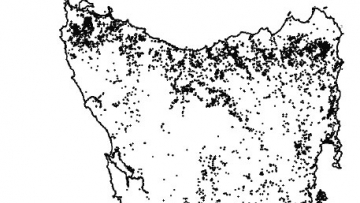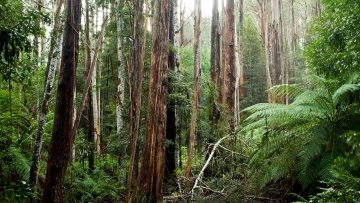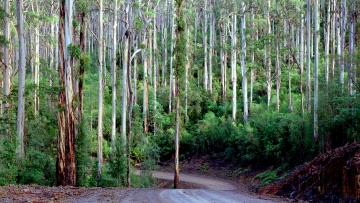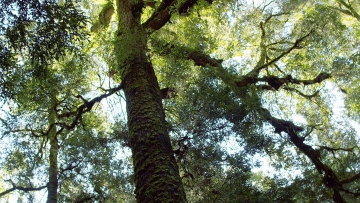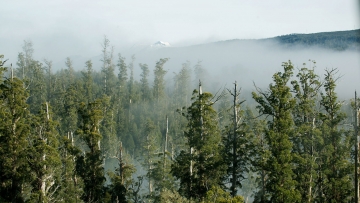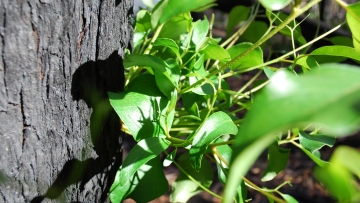
Blackwood forest
Blackwood (Acacia melanoxylon) is widespread throughout Tasmania but is most common in the wet forests of the north-west of the State. Stem form is varied, ranging from gnarled and twisted trees in gullies on the east coast to magnificent straight-boled trees in the swamps of the north-west.
The natural distribution of blackwood extends from the Atherton Tableland in northern Queensland through the tablelands and escarpments of N.S.W. and Victoria, to the Mount Lofty Ranges in South Australia and to southern Tasmania. It occurs at altitudes from sea level to 1500 m in northern N.S.W. (Boland et al. 1984) and 1000 m in central Tasmania. It is most common in cool humid areas of low frost intensity and moderate to high annual rainfall (about 1500 mm).
Blackwood has a wide ecological range and commonly occurs in wet sclerophyll forest, mixed forest, disturbed rainforest and teatree swamps. It occurs occasionally in dry sclerophyll forest. The map below shows occurrences of blackwood within Tasmania as recorded on the GT Spot database (DPIWE 2005).
Blackwood has a long history of use for shingles, palings, sawn boards, veneers and barrel staves. The swamps of Smithton have been Australia’s prime source of high quality blackwood timber for almost a century. Much of the original blackwood swamp forest was cleared for agriculture, a practice which effectively ceased in the 1970s.
The supply of blackwood in Tasmania is drawn from two main sources:
- the blackwood swamps in north-western Tasmania; and
- as a secondary product (arisings) from the harvest of blackwood-rich wet eucalypt forest.
The blackwood swamps supply a sustainable sawlog yield with harvesting undertaken on a 70-year rotation. Arisings from the harvest of wet eucalypt forest will continue, but at a reduced level, as the proportion of regrowth forest harvesting increases. An additional resource is being created by the fenced-intensive-blackwood program, which established over 1500 ha of fenced eucalypt/blackwood regeneration between 1985 and 2005.
Blackwood forests constitute about 0.4% (29,700 ha)* of the State’s forested area (3.3 million ha)
* Based on TASVEG 3.0 (Citation: Department of Primary Industries, Parks, Water and Environment. TASVEG 3.0, Released November 2013. Tasmanian Vegetation Monitoring and Mapping Program, Resource Management and Conservation Division)
For natural regeneration of blackwood to be successful the following must be present:
- Ground-stored seed source. Blackwood seed, dropped to the ground over previous decades, is the basis of natural regeneration systems for blackwood forests in Tasmania. This seed is available on site, is of the correct provenance, and saves the costly and time-consuming process of collecting and sowing of seed. However, seed distribution may be patchy due to localised seedfall, and blackwood regeneration cannot be expected where there was no blackwood growing in the previous forest.
- Disturbance such as harvesting or fire is required to stimulate blackwood germination by cracking the hard protective seed coat, and to provide a suitable seedbed for seedling establishment
- Sufficient light for vigorous height growth. Blackwood is not always the dominant tree species within a forest being managed for blackwood production. It is less shade sensitive than eucalypts however over-topping by other crowns will adversely affect the form and vigour of blackwood.
- Sufficient side shade for lower branch suppression. Blackwoods of good stem form are usually found where side-shading, provided by the surrounding vegetation, helps to suppress the lower branches of the blackwood saplings as they grow. This naturally occurs where blackwood is growing in “light-wells” or small gaps in the canopy. In larger gaps or clearfelled areas, a “nurse” species is required. Nurse species can include young eucalypts, teatrees and paperbarks and wet sclerophyll understorey species (particularly Pomaderris apetala). At high densities, these species compete with the blackwood seedlings resulting in rapid branch suppression and good stem form. Open grown trees usually show poor bole form.
- Protection from browsing. Blackwood seedlings are highly palatable to native mammals, domestic livestock and rabbits. All blackwood regeneration systems must include effective browsing control.
Blackwood is predominantly a co-dominant or understorey species; therefore its regeneration treatment is often largely determined by the need to provide suitable nurse species.
Blackwood also occurs as a common understorey species in other eucalypt forest communities and regeneration can occur from ground-stored seed following harvesting. Heavy browsing usually reduces the stocking to a level comparable to that of the original forest.
Specific silvicultural treatments, such as fencing to increase the proportion of final crop blackwoods, are not economically justified in eucalpyt forest communities since stocking levels are low and growth rates are slow. Normal silvicultural operations in eucalypt forest should be sufficient to ensure that the blackwood understorey component is maintained on the site.
More detailed information can be found in Blackwood (PDF) part of our Science and Technical papers list in Publications.
